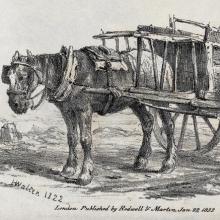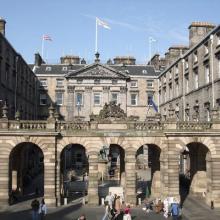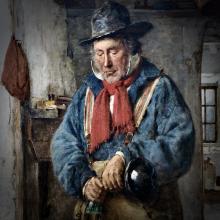
1857
DISTRESSING FATAL ACCIDENT—Yesterday, a portion of an old wall in Jamaica Street Lane fell upon two children at play beside it; one of them was killed on the spot, the other much hurt.
The wall, which was not in good repair, is perhaps a little more than three feet high from the pavement of the lane, but on the other side there is a sunk area in front to the house No. 21, the depth of which from the ridge of the wall must be fully six feet.
John Gibson, a carter with Younger & Co., was driving a brewer’s cart through the lane, and had stopped his horse close by the wall, and left it there for a moment. The horse became restive, and, turning its head towards the middle of the lane, the back of the cart was thrust against the wall, making a breach, the stones from which fell into the area on the children who were playing there.
Ann Rae, aged twelve, was killed on the spot, the other child, Elizabeth Hay, aged nine, was seriously injured, though it is understood she will recover.[1]
Scotsman, 24 June 1857
Image above: chalk lithograph by H. Walter; Wellcome Collection. Attribution 4.0 International (CC BY 4.0).
[1] Ann Rae was the daughter of Joseph Rae (a deceased chimney sweep) and Janet Rae or Barclay, née Dalziel. She lived at 21 Jamaica St (SR Deaths 685/7 231).
*****
SHERIFF SUMMARY COURT.—Sheriff Jameson disposed of the following cases yesterday: […] —Peter Gordon, cab-proprietor, was found guilty of assaulting one of his men in Gayfield Lane, and was sentenced to 30 days’ imprisonment, and to find L.10[2] caution for his good behaviour during the next six months, or remain in prison for 30 days more.
Caledonian Mercury, 18 August 1857
[2] About £590 today, or 50 days’ wages for a skilled tradesman in 1847.
*****
DESTRUCTIVE FIRE AT GREENSIDE.—On Saturday the extensive cabinet and upholstery works of Mr R. Sandeman, situated at Greenside, were entirely destroyed by fire.
The premises, consisting of four flats, and a wood yard, are situated at the north-west corner of the Calton Hill, and behind Blenheim Place.
How the fire originated, or how long it may have been burning before it was discovered is not known, but it is supposed to have begun first in the packing house among the steam. The alarm was first given shortly after ten o’clock, but the fire had obtained considerable way, and the dense smoke gathering on the stair-case, which is on the west-end of the building, it was with difficulty some of the men escaped. Three of them who were in the farther end of the second flat finding it impossible to get out by the stair, leaped from one of the back windows, a height of about 25 feet. They were all seriously injured.
Mr Mitchell and the fire-brigade were promptly at the spot, but owing to the combustible nature of the materials the flames had spread so rapidly that, by the time the engines arrived, the fire had obtained such ascendancy as to render their efforts to save any portion of the building fruitless.
Although a detached tenement, by its contiguity to Blenheim Place on the north-east, and Greenside Church on the south-east, some fears were entertained for these properties, and the exertions of the firemen were directed to the confinement of the fire to the burning pile.
At first, it was hoped that the wood-yard might be saved, as the wind was southerly; the wind, however, veered round considerably to the north, and as the conflagration of the workshops reached its height, the burning embers fell upon the roof of the shed and saw-pits, which almost immediately fell a prey to the flames.
The centre yard, which was more than normally stocked with cut wood, a large amount of which had been lately racked, was then soon in a blaze. Mr Sandeman and his men, with a few energetic strangers, endeavoured to save some of the furniture. Not expecting that the wood would have perished so soon, a few of them were driven to the end of the yard, which was opposite the entrance, where they had to be drawn up to the Terrace by ropes.
About 30 logs remain more or less injured; a very few articles in the workshops were got out, and only one of the men, nearest the door had time to pull his chest down the stair. With this exception, the whole of the workmen’s tools are burned. Only six or seven of the men had them insured.
We understand that it is Mr Sandeman’s intention to re-erect the shops immediately, and in the meantime, accommodation having been procured elsewhere, the work can be carried on so that none of the workmen will be out of employment except those who are injured.
The fire was got under about two o’clock, but not until the large building was wholly gutted, so that nothing but the few logs of unburnt wood and the four bare blackened walls remain. It is gratifying to have to state that Mr Sandeman is fully insured. In December 1836, the whole establishment of the late Mr Sandeman (father of the present proprietor) was burned down. At the time the premises were situate near where the wareroom is now, at the head of Greenside Street.[3]
Caledonian Mercury, 28 September 1857
[3] On that occasion, in addition to Sandeman’s property at Nos 8–9 Greenside St, 13 other tenements were destroyed and 60 families displaced. It was the worst fire in Edinburgh since 1824. See Ordnance Survey map HERE.
*****

BELGIAN DRAUGHT HORSES[4]
QUEENSFERRY STREET LANE.
In consequence of the depression at present,[5]
MR JAMES LAING begs to intimate to his numerous customers that he will NOT have another Sale of those Horses consigned to him from Belgium till about the SECOND WEEK in December, when he will have a first-rate Lot to dispose of. Full particulars and Day of Sale will appear in North British Advertiser.
Queensferry Street Lane,
Edinburgh, 21st November 1857.
Edinburgh Evening Courant, 21 November 1857
[4] A particularly strong breed, also known as the Brabant, Brabançon, and Belgian Heavy Horse. Image above is from Wikimedia, creative commons.
[5] The commercial crisis of 1857 began in the USA and climaxed in New York in Oct. An international chain of bank and mercantile failures was triggered. Requests for help depleted the Bank of England’s supply of notes, and in Nov. it suspended the 1844 Bank Act. Borrowing was curtailed. The crisis lasted for about a year in the UK.
*****
Correspondence
FIRES IN GREENSIDE AND GEORGE STREET
(TO THE EDITOR OF THE CALEDONIAN MERCURY)
SIR—I have to furnish you, for the information of the public, with a few details connected with those fires.
The alarm at Greenside was given by a woman who saw a gleam through a window of the storey from the opposite side of the street, and by a boy about ten years of age named Murray, who was in the lobby of the post office by twenty minutes after ten to give notice to his father there.
In about ten minutes after it assumed a most threatening aspect. A number of workmen were engaged at their benches, and instantly fled for safety, driving out the sash of the window about the sixth west from where the flames were rapidly gaining the mastery, and dropped about a height of twenty feet, one after the other.
Others effected their escape by similar means. A plank was obtained to place against the wall, upon which they might slide down, but by the time it was fixed there the workshop was deserted by the frightened inmates. The flames burst forth with great fury from several windows, ascending to the flats above, which were soon, with the flats below, in one dreadful irruption of raging fire.
The smoke was scarcely visible, being almost entirely consumed by the sheets of flame, which, like the sails of a magnificent man-of-war, flapped to the attracted breeze. It may easily be conceived that the heat was most intense.
No person could approach near the tenement, which is a declined building within a walled inclosure forming a square, the workshops occupying the north side, the remainder of the area being used as a woodyard, in which deposited large logs of wood, as imported, a quantity of cut timber set up to winnow,[6] with piles of planks and slabs. In the warerooms were valuable veneers and many articles of furniture finished and finishing in “Sandeman’s” proverbial best style.
The whole hypothec[7]—lofty and long ranges of workshops, logs, piles, boards, tools, furniture, and growing trees—were crackling in one mighty furnace, sending up flakes and embers high into the air, to a brisk wind, blowing at that spot from the north-west. The combustibles (pardon the digression) were just the kind of fuel to have made one national bonfire upon a scale of magnificent splendour, worthy of commemorating the achievement of some marvellous victory.
The hillside upon the south was covered with wondering, admiring, and sympathising, but withal helpless spectators, forming a tableau of surpassing interest. The mob was motionless, except by gaining accession to the mass, while within the circle the devouring element was bearing down every obstacle.
Arriving at the spot immediately after the first outbreak, I passed on to the houses in Blenheim Place, in proximity to the burning building, where I was soon joined by Sergeant Auld of the Police and Robert Ross, who received medals for their exertions at the James’ Court fire. Here we considered what it was best to do, and resolved to place a bucket full of water to be ready in the event of flames igniting to extinguish it instantly on the first appearance, as by this time the houses and stables on the opposite side of Greenside Lane were beginning to smoke with the extending heat.
Mr Mitchell, fire master, was early on the ground and surveyed the premises that he might direct his brigade to play on the part most likely to be effective for staying the progress of the fire, and so that Blenheim Place might be saved. Mr Spalding the active and energetic foreman was there fully equipped—reels, engines, and the whole apparatus, with a complete staff of the Fire Brigade, were in an incredibly short space of time ready for action.
Fortunately the water officer of the district had the water put on and was in Greenside as soon as the engines. The play began and success attended the labours of the firemen. One director pointed at the windows on the north side, another from the roof of the flat building at Blenheim Place poured upon the rafters, while a third kept watering the eastern gable. A person assisting at this point got his hand cut rather severely, and went off in search of a surgeon.
By half-past eleven the fire was declared, and seen to be subdued, but not until the whole was a total wreck. No lives were lost, and no damage done by water to the dwelling houses upon which it was found unnecessary to operate beyond the removal of furniture.
Besides the persons named above, there were a whole host rendering the most active assistance. A. young generation connected with the Post Office, whose name I ascertained to be Mr Alexander Somerville, gave most efficient help to the inhabitants of the common stair nearest the fire, by carefully collecting their most valuable articles, and otherwise advising as to their protection. No. 94, Michael Sullivan, kept vigil over the deposits.
Lieutenant M’Lennan and Sergeant Faulkner (No. 2) were exceedingly active. Councillor Ford, Convenor of the Fire-engine Committee; Mr Bailies Blackadder, Stephenson, and others were all ready to give such orders and advice as might be requisite. While the brigade and assistants were beginning to haul out the logs from the yard, another alarm of fire in George Street rendered it necessary that they should be withdrawn. …
Caledonian Mercury, 28 September 1857
[Fire engine image: Wikimedia, creative commons.]
[6] Season in the open air.
[7] In Scots law, a property obtained in payment of a debt.
*****
AN UPROARIOUS CHARACTER.
Hugh Somerville, residing in Albany Street, was found guilty of committing breach of the peace in the house of Margaret Diey, Regent Terrace Lane. He having been exceedingly uproarious, was sentenced to pay a fine of 30s, and find caution for his behaviour to the extent of L 20.[8]
Caledonian Mercury, 15 October 1857
[8] A fine of about £89 today, or a week’s wages for a skilled tradesman in 1857; a caution of about £1,800 today, the value of a horse or 100 days' wages for a skilled tradesman.
*****



